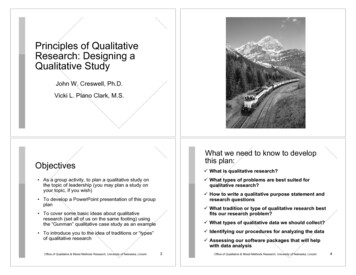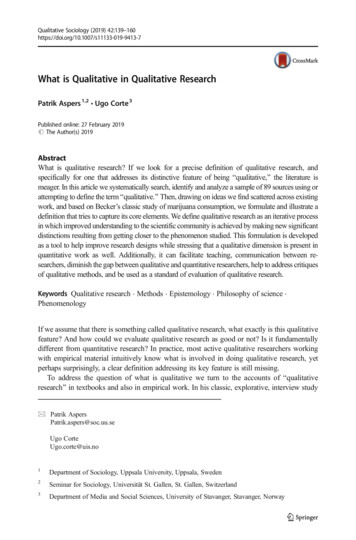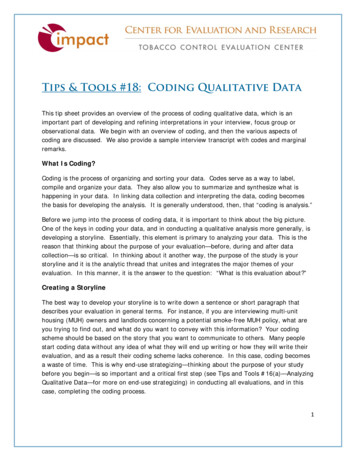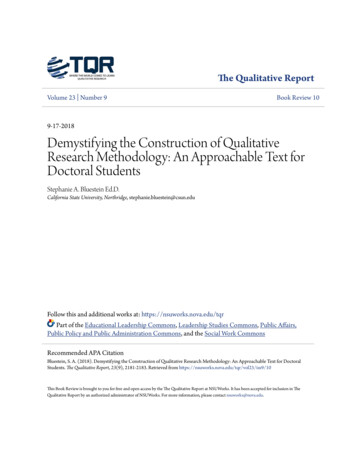
Transcription
Proceedings of the 2014 International Conference on Industrial Engineering and Operations ManagementBali, Indonesia, January 7 – 9, 2014A Qualitative Study of the Critical Success Factors of ERP System A Case Study ApproachAamir IjazInstitute of Chemical Engineering & TechnologyUniversity of the PunjabLahore, PakistanR. K. MalikBahria UniversityIslamabad, PakistanRab Nawaz LodhiDepartment of Management SciencesCOMSATS Institute of Information TechnologySahiwal, PakistanUmie HabibaNational College of Business Administration and EconomicsLahore, PakistanSyed Muhammad IrfanDepartment of StatisticsCOMSATS Institute of Information TechnologyLahore, PakistanAbstractThe aim of the present study was to explore Critical Success Factors (CSFs) in implementation, pre-implementationand post-implementation phases of ERP system. A single exploratory case study approach has been employed toanalyze the case of an electric supply Government owned company of Pakistan. For the collection of data face-toface in-depth interviews were conducted. NVivo 10 software has been used for the in-depth qualitative analysis.Many techniques have been used for the validation of different themes of the study such as Coding Nodes, WordTree, Word Tag Clouds and Tree Map. This study found six CSFs of ERP in pre-implementation phase, twelveCSFs during the phase of ERP implementation and six CSFs in pre-implementation stage. This study also givesgeneral recommendations for ERP consultants and ERP end-user companies for the successful implementation ofERP system.KeywordsERP system, Critical Success Factors (CSFs), Case Study, Phases of ERP implementationIntroductionEnterprise Resource Planning (ERP) system is one of the very complex information systems for theorganization (Umble & Umble, 2003). It integrates all departments with the organization and automates allprocesses. ERP system implementation is a big challenge for every organization. Different factors influencepositively or negatively on the successfulness in implementation of ERP system. These factors are known as criticalfactors. Critical success factors (CSFs) become the reasons of successful implementation of ERP system. Pinto andSlevin (1987, p.22) defined CSFs as “factors which, if addressed, significantly improve project implementation2556
chances”. Rockart (1979, p.85) defined CSF as “the limited number of areas in which results, if they are satisfactory,will ensure successful competitive performance for the organization”.The present study aims to identify CSF in different phases of ERP system implementation. This study hasdifferent sections: first section discusses the introduction, second section describes the review of literature, thirdsection explains research problem along with research objectives of the study, fourth section shows conceptualframework, fifth portion describes research methodology, sixth section shows the findings of the study and it the lastsection conclusion and recommendations have been discussed.Review of LiteratureMartin (1998) stated that most of the ERP implementations are over budget or late in completion. Anotherauthor stated: “an effective IT infrastructure can support a business vision and strategy; a poor, decentralized onecan break a company. More and more companies are turning to off the-shelf ERP solutions for IT planning andlegacy systems management” (Holland & Light (1999, p.1). Nielsen (2002) investigated Austrian Universities tofind different CSFs of ERP project. Using the case study approach Nielsen confirmed 22 different CSFs andexplored four new CSFs of ERP system such as service for students, competitive edge, system ownership andknowledge management. Figure 1 shows ERP implementation process model by Holland & Light (1999) where theycategorized CSFs of ERP system implemenation into two categories: strategic and tactical.Figure 1Adapted from Holland & Light (1999)Umble & Umble (2003) identified different CSFs of ERP project such as commitment by top management,understanding of strategic goals, data accuracy, managing change, education & training and implementation team.Sun et al. (2005) also identified different CSFs that influence the cost, schedule and goal achievement of an ERPProject. They found that people are very critical in successful implementation of ERP system. Different studies usedcase study and field survey methods to idenfify differnet cricial success factors of ERP implemnation (Yingjie,2005; Finney & Corbett, 2007; Plant & Willcocks, 2007; He, 2007; Nattawee & Siriluck 2008; Ngai et al., 2008;Tan et al., 2009; Fang & Patrecia, 2009; Moohebat et al., 2010; Ganesh & Mehta, 2010; Pabedinskaite, 2010)whereas Garg (2010) Pareto Analysis of existing literature and Upadhyay et al. (2010) compared CSFs and theirsignificance in developed and developing countries whereas, Maldonado (2009) investigated the relation of differentfactors on the successful implementation of ERP system project.THE RESEARCH PROBLEMSGarg (2010) stated that companies do not show the failure of ERP system implementation however, ERP failure rateis very high. Different factors influence positively or negatively on the successful implementation of ERP system.Different studies identified these critical success and failure factors of ERP system implementation. CSFs becomethe reasons of successful implementation of ERP system. We can also say, that these factors positvely influence onthe succesfulness of ERP implementation. The particular problem statement of the present study is:“to find critical success factors (CSFs) in differnet phases of ERP system implementaiton in thecontext of Pakistan”2557
RESEARCH OBJECTIVESCSFs occur in all statege of ERP implemenation: pre-implemenation, implemantion and postimplemenation. However, few studies have addressed CSFs ERP system in different stages of implementation. Theobjectives of the study are:1. To identify critical success factors in pre-implementation phase of ERP System2. To identify critical success factors in the phase of implementation of ERP System3. To identify critical success factors in post-implementation phase of ERP System4. To explore significance of each critical success factor in different phases of ERP implementation5. To give general recommendations to organizations and ERP consultants for the successful implementationof ERP systemCONCEPTUAL FRAMEWORKFigure 2 shows the conceptual framework of the study where ERP system implementation has been dividedinto three stages: implementation, pre and post implementations. This three stage model also shows CSFs associatedwith the each phase. On the bases of this framework the present study identified different CSFs in these three stagesof ERP implementation.Figure 2: Conceptual Model of the StudyRESEARCH METHODOLOGYThis study employed case study approach guidelines of Yin (2009). Case study approach is a famous qualitativeresearch strategy for the in-depth analysis of a case.Background of the Case StudyA Government owned electric supply company in Pakistan has been selected where ERP system has beensuccessfully implemented. The company is producing electrify supply to different industrial and domestic customersin a specific regions in Pakistan.Data CollectionFifteen face to face interviews of ER end users and consultants have been conducted (including six video recordingsof 30-45 minutes. Different semi-structured and sometimes unstructured questions were asked to respondents.A convenience sampling technique was used because of the nature of the study. Convenience sampling is the mostappropriate method in qualitative research to dig out the realities after the in-depth analysis. ERP end users andsome of the member of ERP consultant team participated for the interviews. These respondents were the permanentemployees and contractual consultant of ERP system. Figure 3 shows Pie Chart of employment status ofrespondents: 20% from contractual consultant, 40% from middle level management, 20% from lower levelmanagement, and 20% from top level management.Data Analysis ProcedureCase study strategy has been used for the in-depth analysis of the company where ERP system has beenimplemented. Using NVvio 10 software different techniques have been used for the qualitative data analysis such ascoding & thematic analysis, word tag clouds, word tree and tree map. NVivo is strong and very helpful forqualitative data analysis (Ozkan, 2004). However, the methodology for applying different techniques using NVivodepends on the researchers who are applying different techniques.Many techniques have been used for the validation of different themes of the study such as Coding Nodes, WordTree, Word Tag Clouds and Tree Map. Data has been analyzed in different phases: first of all recorded data has beentranscribed into textual form, then different themes have been identified from the textual data, after that all relatedtextual data has been coded into different related themes. This study also used “word tree map” and “world tagclouds” for collecting more evidences for the strength and validity of different themes. After applying all these2558
techniques, the study also used “Tree Map” to check the significance of each critical success factors in differentphases of ERP system implementation.Figure 3 Pie Chart: Employment Status of RespondentsFINDINGS OF THE STUDYWord Tag CloudsFigure 4 shows “Word Tag Clouds” which shows the size of different words according to their frequencies ofrepetition in textual data. Words having more frequency show their big size. This study applied Word Tag Cloudsinto two phases of analysis: before funneling approach and after funneling approach. In figure 4, Word Tag Cloudsshows different unrelated words such as 2011, an, can, cell, com, different, during, email, end, every, failure, first,how, iqbal, made, more, mr, much, need, new, now, number, side, so, them, thing, think, two, us, were what andyou. These words are not the themes of the study.Figure 4Before Funneling: Word Tag CloudsIn the second phase of word tag clouds these unrelated words have been added into “stop word list” andthen words tag clouds technique has been applied and in figure 5, Word Tag Clouds shows different themes of thestudy such as activities, assets, automatically, change, consultant, control, critical, data, department, efforts, erp,finance, financial, implementation, information, level, long, management, manager, monitor, network, newsletter,oracle, organization, people, process, success, successful, support, synergy, system, team, training and vendor.2559
Figure 5After Funneling: Word Tag CloudsWord Tree AnalysisImplementation word is the key word for this study. Therefore, using text search query a word tree hasbeen explored for the word: “implementation”. In figure 6, word tree of “implementation” shows the differentpattern of talks of respondents of the study. By reading line by line data where the word “implementation” has beenused, the study observed the meaning of ERP implementation and CSFs of ERP implementation in this study.Figure 6Word Tree of the word “implementation”2560
ERP Pre-Implementation Phase and Critical Success FactorsStacked Bar (figure 7) shows CSFs in pre-implementation phase of ERP System. In this phase, the study found thatclear objectives and scope, complete awareness, organizational analysis, right product selection, team compositionfor product selection and study of organizational culture are the CSFs of ERP System.Figure 7Stacked Bar: ERP Pre-Implementation Phase and Critical Success Factors2561
ERP Implementation Phase and Critical Success FactorsStacked Bar (figure 8) shows CSFs in the phase of ERP system implementation. The study identified BusinessProcess Reengineering, change management, effective communication, effective training, infrastructure, inter-teamcooperation leadership, management involvement, rewards and recognitions, standardized implementation sequence,team composition and top management commitment as the CSFs during the phase of ERP system implementation.Figure 8Stacked Bar: ERP Implementation Phase and Critical Success FactorsERP Post-Implementation Phase and Critical Success FactorsStacked Bar (figure 9) shows CSFs in ERP post-implementation phase. Employee motivation, end user satisfaction,organizational productivity, professional development services, software reliability, support and maintenance havebeen identified as CSFs in post-implementation stage of ERP System.Figure 9 Stacked Bar: ERP Post-Implementation Phase and Critical Success Factors2562
Tree Map Analysis of ERP Critical Success FactorsTree Map shows the significance and the worth of each theme of the study. Tree map (figure 10) shows CSFs ofERP System in different phases of implementation. In implementation phase of ERP system: Team Composition,Management involvement, Standardized Implementation Sequence, Effective Training and Inter-team cooperationhave been found as more critical success factors while business process reengineering, effective communication,leadership, change management, infrastructure, rewards and recognition and top level management commitmenthave been found as less critical factors in the phase of implementation. Similarly, Support and Maintenance, Enduser satisfaction have been found as more critical success factors while organizational productivity, professionaldevelopment, employee motivation and software reliability have been found as less critical success factors in thepost-implementation stage of ERP system. In pre-implementation stage of ERP system implementation ClearObjectives and Scope and Complete Awareness have been found as more critical success factors whileorganizational analysis, team composition for product selection, study of organizational culture and right productselection have been found as less critical success factors in pre-implementation stage of EPR system. Those criticalsuccess factors in the big regions are more critical as compare to those factors which are falling in the small regionof the tree map.Figure 10Tree Map of ERP Critical Success FactorsConclusion and DiscussionsUsing a traditional method of case study research this study was aimed to identify CSFs of ERP system inimplementation, pre-implementation and post-implementation phases. A government owned organization which isengaged has been selected for the in-depth exploration of CSFs. For the collection of data, prior time appointmentswere taken for the smooth conduct of interviews with ERP end users (employees) and ERP consultant teammembers. Six interviews were recorded using video recording device and remaining nine interviews were recorded2563
on paper notes. All qualitative data has been analyzed using the famous software; “NVivo” a product of QSRInternational Australia. Clear objectives and scope, complete awareness, organizational analysis, right productselection, study of organizational culture and team composition for product selection have been identified as CSFs inPre-implementation stage of ERP System.The study identified Business Process Reengineering, change management, effective communication,effective training, infrastructure, inter-team cooperation leadership, management involvement, rewards andrecognitions, standardized implementation sequence, team composition and top management commitment as theCSFs during the phase of ERP system implementation. Different CSFs have been identified in post-implementationstage such as end user satisfaction, employee motivation, organizational productivity, software reliability,professional development services and support & maintenance. In Pre-implementation stage of ERP System studyfound different CSFs such as Clear objectives and scope, complete awareness, organizational analysis, right productselection, study of organizational culture and team composition.General RecommendationsThis study presents different recommendations to those companies where ERP system is being implemented or theyare planning to implement ERP system. Moreover, these recommendations are also useful for ERP consultants:1. Organization should conduct business process reengineering to make fit the organization as per differentrequirements of ERP system.2. Organization should mange the change at individual, workgroup and organizational levels.3. Organization should make an effective communication system among employees, top level managementand ERP consultants to avoid the discrepancies.4. Organization should arrange effective training for the end users of ERP system. Continuous training maysolve many problems even in the post-implementation of ERP system.5. Company should develop a sufficient infrastructure to fulfill all requirements of ERP system. Effectivenetwork system, hardware and other technologies also lead to the successful implementation of ERPsystem.6. Inter-team and inter-departmental coordination is also CSF during the phase of ERP implementation.Therefore companies should make an environment in which all teams can share their expertise and workwith coordination.7. All top level and middle level management should involve in each phase of ERP implementation. Theyshould show their devotion and ownership.8. Organization should follow a standardized sequence for the implementation of ERP system.9. Team composition is most critical factor found during the phase of ERP implementation. Therefore,company should develop internal team and they should work with the cooperation of ERP consultant teammembers.10. Top level management should show their commitment to complete the task in time and they shouldsupervise all activities in different phases of ERP system implementation.11. Company should develop a team for the selection of ERP system that can fulfill the need of the company.An effective decision for the selection of right product leads toward the successful implementation and useof ERP system.12. Company should conduct a need analysis before selection of ERP system.13. Top level management should understand organizational culture and should make policies how to tackleexpected problems14. Organization should make clear objectives, vision and target dates in pre-implementation stage to plan eachand every thing relating to cost, resources and time.References1.2.3.4.Belbag, S., Cimen, M., Tarim, S., & Tas, A. (2009). A Research on Corporate Enterprise Resource Planning(ERP) Systems used for Supermarket Supply Chain Inventory Management in Turkey. European Journal ofScientific Research , 486-499.Carr, J. E., & Hasan, M. (2008). An empirical study of performance measurement systems in manufacturingcompanies. Journal of Achievements in Material and Manufacturing Engineering , 616-621.Ehie, I. C., & Madsen, M. (2005). Identifying critical issues in enterprise resource planning (ERP)implementation. Computers in Industry, 545-557.Fang, L., & Patrecia, S. (2009). Critical Success Factors in ERP Implemenation. J ÖNKÖP ING INT E RNATIONAL BUS INE S S S CH OO L, JÖNKÖPING UNIVERSITY.2564
3.24.25.26.27.28.29.30.31.32.Finney, S., & Corbett, M. (2007). ERP implementation: a compilation and analysis of critical success factors.Business Process Management Journal, 329-347.Ganesh, L., & Mehta, A. (2010). Critical success factors for successful enterprise resource planningimplementation at Indian SMEs. International Journal of Business, Management and Social Sciences, 65-78.Garg, P. (2010). Critical Success factors for Enterprise Resource Planning implementation in Indian RetailIndustry: An Exploratory study. International Journal of Computer Science and Information Security.He, Y. (2007). A Comparative Study of Critical Success Factors for ERP System Implementation in China andFinland. Master of Science Thesis in Accounting, Swedish School of Economics and Business Administration.Holland, C. P., & Light, B. (1999). A Critical Success Factors Model for ERP Implementation. IEEE Software.Hawking, P., Foster, S., & Bassett, P. (2002). An Applied Approach to Teaching HR Concepts Using an ERPSystem. Informing Science , 699-704.Kashef, A. E., Izadi, M., & Al-Sehali, S. H. (2001). ERP: The Primary Solution Provider for IndustrialCompanies. Journal of Industrial Technology , 1-6.Lau, L. K. (2003). DEVELOPING A SUCCESSFUL IMPLEMENTATION PLAN FOR ERP:Issues andChallenges. IACIS , 223-229.Martin M.H. (1998). “An ERP Strategy,” Fortune, 2 Feb., pp. 95-97.Moohebat, M. R., Asemi, A., & Jazi, M. D. (2010). A Comparative Study of Critical Success Factors (CSFs)in Implementation of ERP in Developed and Developing Countries. International Journal of Advancements inComputing Technology.Motwani, J., Subramanian, R., & Gopalakrishna, P. (2005). Critical factors for successful ERPimplementation: Exploratory findings from four case studies. Computers in Industry, 529-544.Markus, M., Tanis, C., & Fenema, P. (2000). Multisite ERP Implementation. Communication of the ACM , 4246.Mokhtar, S. S., Yusoff, R. Z., & Arshad, R. (2009). Market Orientation Critical Success Factors of MalaysianManufacturers and Its Impact on Financial Performance. International Journal of Marketing Studies , 77-84.Nattawee, A., & Siriluck, R. (2008). Developing ERP Implementation success factors of Thai SME's.GMSARN International Conference on Sustainable Development: Issues and Prospects for the GMS.Ngai, E., Law, C., & Wat, F. (2008). Examining the critical success factors in the adoption of enterpriseresource planning. Computer in Industry.Nicolaou, A. I., & Bhattacharya, S. (2006). Organizational performance effects of ERP systems usage: Theimpact of post-implementation changes. International Journal of Accounting Information Systems , 18-35.Okrent, M. D., & Vokurka, R. J. (2004). Process mapping in successful ERP Implementations. IndustrialManagement & Data Systems , 637-643.Ozkan, B. C. (2004). Using NVivo to Analyze Qualitative Classroom Data on Constructivist LearningEnvironments. The Qualitative Report.Pinto, J. and Slevin, D. (1987). Critical Factors in Successful Project Implementation. In: IEEE Transactionson Engineering Management, 34(1), 22-27.Plant, R., & Willcocks, L. (2007). Critical Success Factors in International ERP Implementations: A CaseResearch Approach. Journal of Computer Information System.Rockart, J. (1979). Chief Executives Define Their Own Information Needs. In: HarvardBusiness Review,March/April 1979, 81-92.Santos, D. B., Peffers, K., & Mauer, D. C. (1993). The Impact of Information Technology InvestmentAnnouncements on the Market Value of the Firm. Information Systems Research , 1-23.Scheurwater, M., & Arons, B. D. (2008). ERP & Performance. KPMG IT Najaarsevent , 10-16.Shaukat, M., & Zafarullah, M. (2009). Impact of Information Technology on Organizational Performance: AnAnalysis of Qualitative Performance Indicators of Pakistan’s Banking and Manufacturing Companies.European Journal of Economics, Finance and Administrative Sciences, 37-49.Sun, A. Y., Yazdani, A., & Overend, J. D. (2005). Achievement assessment for enterprise resource planning(ERP) system implementations based on critical success factors (CSFs). International Journal of ProductionEconomics, 189-203.Tan, W.-g., Cater-Steel, A., & Toleman, M. (2009). Implementing IT service management: a case studyfocusing on critical success factors. Journal of Computer Information System.Umble, E. J., Haft, R. R., & Umble, M. M. (2003). Enterprise resource planning: Implementation proceduresand critical success factors. European Journal of Operational Research, 241-257.Yingjie, J. (2005). Critical Success Factors in ERP Implementation in Finland. M.Sc. Thesis, The SwedishSchool of Economics and Business Administration.2565
BiographyAamir Ijaz is a Professor, and Director of Institute of Chemical Engineering & Technology, Quality EnhancementCell (QEC) and Office of Research Innovation and Commercialization (ORIC), Lahore, Pakistan. He did his Ph.D.in Chemical Engineering from University of London, Queen Mary Westfield College, U.K., Master of Science inNuclear and Energy Engineering from University of Arizona, Tucson, Arizona, USA, Master of Science in NuclearEngineering form University of Quaid-i-Azam, Islamabad and B.Sc. in Chemical Engineering, from University ofthe Punjab, Lahore. He has published 26 research papers in well reputed national and internationals journals andattended 10 International conferences and presented his research papers. He is a member of several executivecommittees in University of the Punjab, Lahore. In international intensity he is a member of APQN and PakistanEngineering Council. In familiarity of his field, masses of students complete their research projects of M. Phil andPh.D under his supervision.2566
ERP system, Critical Success Factors (CSFs), Case Study, Phases of ERP implementation Introduction Enterprise Resource Planning (ERP) system is one of the very complex information systems for the organization (Umble & Umble, 2003). It integrates all departments with the organization and automates all processes.











